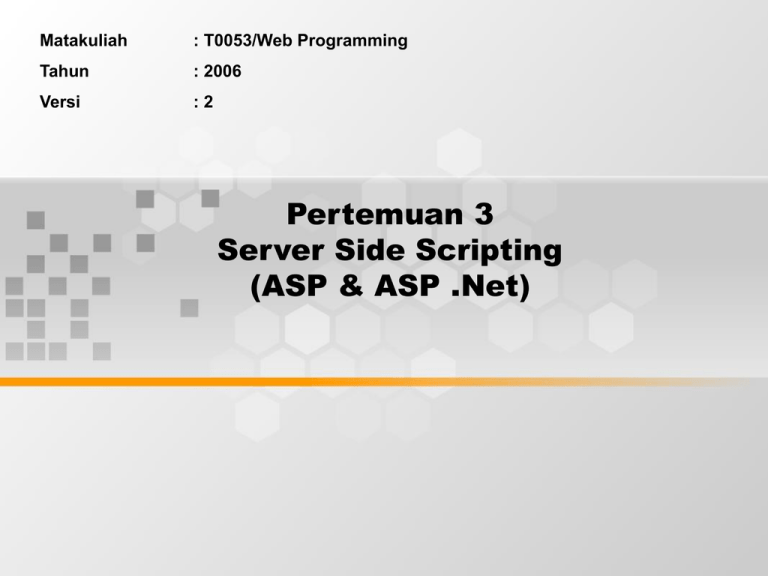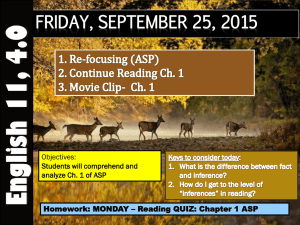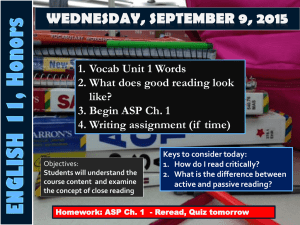
Matakuliah
: T0053/Web Programming
Tahun
: 2006
Versi
:2
Pertemuan 3
Server Side Scripting
(ASP & ASP .Net)
Learning Outcomes
Pada akhir pertemuan ini, diharapkan
mahasiswa akan mampu :
• Menjelaskan konsep server side scripting
• Membuat program menggunakan ASP &
ASP .Net
Material Outline
• Mengenal Server side scripting
• Pemrograman dasar ASP & ASP .Net
• Koneksi ke database
Server Side Scripting
• Server Side Scripting is script that execute
in web server (IIS, Apache Web Server,
etc)
• Server Side Scripting very useful if require
validation against database, server
processing and security.
Introduction to ASP
• ASP (Active Server Pages) is server side scripting from Microsoft
that usually uses Internet Information Services (IIS) as web server.
• Active Server Pages (ASP)
– Processed in response to client request
– ASP file contains HTML and scripting code
– VBScript de facto language for ASP scripting
• Other languages can be used
– JavaScript
– .asp file extension
– Microsoft-developed technology
– Send dynamic Web content
•
•
•
•
•
HTML
DHTML
ActiveX controls
Client-side scripts
Java applets
How ASP Work
• Client sends request
– Server receives request and directs it to ASP
– ASP processes, then returns result to client
• HTTP request types
– Request methods
• GET
– Gets (retrieves) information from server
– Retrieve HTML document or image
• POST
– Posts (sends) data to server
– Send info from HTML form
» Client-entered data
» Info to search Internet
» Query for a database
» Authentication info
How ASP Work
• Browsers often cache Web pages
– Cache: save on disk
– Typically do not cache POST response
• Next POST request may not return same result
• Client requests ASP file
– Parsed (top to bottom) by ActiveX component asp.dll
• ActiveX component: server-side ActiveX control that usually does
not have GUI
• Code executed as encountered
• @LANGUAGE statement
– Specifies scripting language
– If not used, VBScript assumed
• As interpreted, HTML (plus client-side scripts) sent to client
– Parsed each time requested
– Web server must support ASP by providing component such as
asp.dll
Client Side VS Server Side
• Client-side scripting
– Used for:
•
•
•
•
•
•
Validation
Interactivity
Enhancing Web page with ActiveX controls
Dynamic HTML
Java applets
Accessing browser
– Browser-dependent
• Scripting language must be supported by browser or scripting
host
– Viewable on client
• Protecting source code difficult
Client Side Vs Server Side
• Server-side scripting
– Reside on server more flexibility
• Database access
– Usually generate custom response for client
– Access to ActiveX server components
• Extend scripting language functionality
– Run exclusively on server cross-platform
issues not a concern
– Not visible to client
• Only HTML + client-side scripts sent to client
ASP Example
• Scripting delimiters
– <% and %>
– Indicate code is to be executed on server, not
client
• @LANGUAGE
– Specify scripting language (default VBScript)
– <% @LANGUAGE = “VBScript” %>
• Each time page refreshed, server loads
and interprets ASP
1<% @LANGUAGE = VBScript %>
2<% Option Explicit %>
Outline
3<!DOCTYPE HTML PUBLIC "-//W3C//DTD HTML 4.0 Transitional//EN">
4<% ' Fig. 26.1 : clock.asp %>
5
1.1 Specify VBScript as
scripting language
6<HTML>
7<HEAD>
8<TITLE>A Simple ASP Example</TITLE>
9<META HTTP-EQUIV = "REFRESH" CONTENT = "60; URL = CLOCK.ASP">
10</HEAD>
11<BODY>
12
13<FONT FACE = ARIAL SIZE = 4><STRONG>Simple ASP Example</STRONG>
14</FONT><P>
15
<TABLE BORDER = "6">
16
<TR>
17
<TD BGCOLOR = "#000000">
18
<FONT FACE = Arial COLOR = "#00FF00" SIZE = 4>
19
20
<% =Time() %>
</FONT>
21
</TD>
22
</TR>
23
</TABLE>
24</BODY>
25</HTML>
2000 Deitel & Associates, Inc. All rights reserved.
1.2 Use Option
Explicit to
indicate variables
be explicitly
declared by
programmer
1.3 Use META tag to set
refresh interval
Time gets current time
on server
(hh:mm:ss)
Short for <% Call
Response.Write(
Time() ) %>
Output from a simple Active Server Page
2000 Deitel & Associates, Inc. All rights reserved.
Server Side ActiveX Component
• Server-side ActiveX components
– Typically do not have GUI
– If scripting language for ASP not support
certain feature, create ActiveX Server
component
• Visual C++, Visual Basic, Delphi, etc.
– Usually execute faster than scripting language
equivalents
– Executed on server
• Client does not need to support ActiveX
technologies
Some server-side ActiveX components
included with IIS and PWS
Com p onent Na m e
Desc rip tion
MSWC.BrowserType
ActiveX component for gathering information (e.g., type,
version, etc.) about the client’s browser.
ActiveX component for rotating advertisements on a
Web Page.
ActiveX component for linking together Web pages.
ActiveX component for rotating HTML content on a
Web page.
ActiveX component for storing the number of times a
Web page has been requested.
ActiveX components that provides general-purpose
persistent counters.
ActiveX component that provides information (e.g.,
owner name, owner address, etc.) about a Web site.
ActiveX component that provide an object library for
accessing files on the server or on the server’s network.
ActiveX components that provide an object library for
accessing databases.
MSWC.AdRotator
MSWC.NextLink
MSWC.ContentRotator
MSWC.PageCounter
MSWC.Counters
MSWC.MyInfo
Scripting.FileSystemObject
ActiveX Data Objects (ADO) Data
Access Components
2000 Deitel & Associates, Inc. All rights reserved.
1<% @LANGUAGE = VBScript %>
2<% Option Explicit %>
Outline
3<% ' Fig. 26.3 : rotate.asp %>
4
5<!DOCTYPE HTML PUBLIC "-//W3C//DTD HTML 4.0 Transitional//EN">
6<HTML>
1.1 Create instance of
AdRotator
component
7<HEAD>
8<TITLE>AdRotator Example</TITLE>
9</HEAD>
10
11<BODY>
12<FONT FACE = "Arial" SIZE = 4><STRONG>AdRotator Example</STRONG>
13</FONT><P>
14<%
15
' Declare flagChanger
16
Dim flagChanger
17
18
' Create an AdRotator object
19
Set flagChanger = Server.CreateObject( "MSWC.AdRotator" )
20
21
' Use config.txt to send an advertisement to the client
22
Call Response.Write( _
23
flagChanger.GetAdvertisement( "config.txt" ) )
24%>
25</BODY>
26</HTML>
2000 Deitel & Associates, Inc. All rights reserved.
1.2 Call Response
object’s Write
method to send
advertisement to
client
27 WIDTH 54
Outline
28 HEIGHT 36
29 BORDER 1
30 *
config.txt
31 /images/us.gif
32 http://www.odci.gov/cia/publications/factbook/us.html
33 United States Information
34 20
35 /images/france.gif
1. Header includes
image HEIGHT,
image WIDTH and
image BORDER
width
36 http://www.odci.gov/cia/publications/factbook/fr.html
37 France Information
38 20
39 /images/germany.gif
40 http://www.odci.gov/cia/publications/factbook/gm.html
Asterisk separates
header from
advertisements
41 Germany Information
Image location
42 20
Destination URL
43 /images/italy.gif
44 http://www.odci.gov/cia/publications/factbook/it.html
45 Italy Information
46 20
47 /images/spain.gif
48 http://www.odci.gov/cia/publications/factbook/sp.html
49 Spain Information
50
20 Deitel & Associates, Inc. All rights reserved.
2000
ALT tag
Percentage of time
image appears
Demonstrating the AdRotator ActiveX
component
2000 Deitel & Associates, Inc. All rights reserved.
File System Object
• File System Objects (FSOs)
–
–
–
–
Manipulate files, directories and drives
Read and write text
In Microsoft Scripting Runtime Library
5 FSO types:
• FileSystemObject
– Interact with Files, Folders and Drives
• File
– Manipulate Files of any type
• Folder
– Manipulate Folders (i.e, directories)
• Drive
– Gather info about Drives (local or remote)
• TextStream
– Read and write text files
File System Object
• OpenTextFile(filename, code, create)
– filename - file to open
– code
• 8 - open for appending
• 1 - open for reading
• 2 - open for writing
– create? - if true, creates a new file if does
not exist
FileSystemObject methods
Metho d s
Desc rip tio n
CopyFile
Copies an existing File.
CopyFolder
Copies an existing Folder.
CreateFolder
Creates and returns a Folder.
CreateTextFile
Creates and returns a text File.
DeleteFile
Deletes a File.
DeleteFolder
Deletes a Folder.
DriveExists
Tests whether or not a Drive exists.
FileExists
Tests whether or not a File exists. Returns boolean.
FolderExists
Tests whether or not a Folder exists. Returns boolean.
GetAbsolutePathName
GetDrive
Returns the absolute path as a string.
Returns the specified Drive.
GetDriveName
Returns the Drive drive name.
GetFile
Returns the specified File.
GetFileName
Returns the File file name.
GetFolder
Returns the specified Folder.
GetParentFolderName
GetTempName
MoveFile
Returns a string representing the parent folder name.
Creates and returns a string representing a file name.
Moves a File.
MoveFolder
Moves a Folder.
OpenTextFile
Opens an existing text File. Returns a TextStream.
2000 Deitel & Associates, Inc. All rights reserved.
Some common File properties and methods
Prop erty/ m ethod
Desc rip tion
Properties
DateCreated
Date. The date the File was created.
DateLastAccessed
Date. The date the File was last accessed.
DateLastModified
Date. The date the File was last modified.
Drive
Drive. The Drive where the file is located.
Name
String. The File name.
ParentFolder
String. The File’s parent folder name.
Path
String. The File’s path.
ShortName
String. The File’s name expressed as a short name.
Size
The size of the File in bytes.
Methods
Copy
Copy the File. Same as CopyFile of FileSystemObject.
Delete
Delete the File. Same as DeleteFile of FileSystemObject.
Move
Move the File. Same as MoveFile of FileSystemObject.
OpenAsTextStream
Opens an existing File as a text File. Returns TextStream.
2000 Deitel & Associates, Inc. All rights reserved.
Some Folder properties and methods
Pro p erty/ m etho d
Desc rip tio n
Properties
Attributes
Integer. Value indicating Folder’s attributes (read only, hidden, etc.)
DateCreated
DateLastAccessed
DateLastModified
Drive
Date. The date the folder was created.
Date. The date the folder was last accessed.
Date. The date the folder was last modified.
Drive. The Drive where the folder is located.
IsRootFolder
Boolean. Indicates whether or not a Folder is the root folder.
Name
String. The Folder’s name.
ParentFolder
String. The Folder’s parent folder name.
Path
String. The Folder’s path.
ShortName
String. The Folder’s name expressed as a short name.
ShortPath
String. The Folder’s path expressed as a short path.
Size
Type
Variant. The total size in bytes of all subfolders and files.
String. The Folder type.
Methods
Delete
Delete the Folder. Same as DeleteFolder of FileSystemObject.
Move
Move the Folder. Same as MoveFolder of FileSystemObject.
Copy
Copy the Folder. Same as CopyFolder of FileSystemObject.
2000 Deitel & Associates, Inc. All rights reserved.
Drive properties
Pro p erty
Desc rip tio n
AvailableSpace
Variant. The amount of available Drive space in bytes.
DriveLetter
String. The letter assigned the Drive (e.g., “C”).
DriveType
Integer. The Drive type. Constants Unknown, Removable, Fixed,
Remote, CDRom and RamDisk represent Drive types and have the
values 0–5, respectively.
FileSystem
String. The file system Drive description (FAT, FAT32, NTFS, etc.).
FreeSpace
Variant. Same as AvailableSpace.
IsReady
Boolean. Indicates whether or not a Drive is ready for use.
Path
String. The Drive’s path.
RootFolder
Folder. The Drive’s root Folder.
SerialNumber
Long. The Drive serial number.
TotalSize
Variant. The total Drive size in bytes.
VolumeName
String. The Drive volume name.
2000 Deitel & Associates, Inc. All rights reserved.
Quering Data
<%
'Declare Variables
Dim dcnDB'As ADODB.Connection
Dim rsDB 'As ADODB.Recordset
Dim sqlQuery
'As String
'Find path of database file
filePath = Server.MapPath("depkeu.MDB")
'Open Database Connection
Set dcnDB = Server.CreateObject("ADODB.Connection")
'dcnDB.Open "DBName" - This is for an ODBC Datasource (if set up) or
'
use the below code for opening a Access 2000 DB
dcnDB.ConnectionString = "Provider=Microsoft.Jet.OLEDB.4.0; Data Source="&filePath
dcnDB.Open
'Query and create recordset
sqlQuery = "SELECT * FROM Students ORDER BY LastName,FirstName"
Set rsDB = Server.CreateObject("ADODB.Recordset")
Set rsDB = dcnDB.Execute(sqlQuery)
%>
Quering Data
<% Do Until rsDB.EOF %>
<tr>
<td valign="top"><%=rsDB("StudentID")%></td>
<td valign="top"><%=rsDB("FirstName")%> </td>
<td valign="top"><%=rsDB("LastName")%></td>
<td valign="top">
<!-- dynamically add variable values to hyperlink -->
<a href="update_students.asp?StudentID=<%=rsDB("StudentID")%>">Update</a>
</td>
<td valign="top">
<!-- dynamically add variable values to hyperlink -->
<a href="delete_students.asp?StudentID=<%=rsDB("StudentID")%>"><font
color="red">Delete</font></a>
</td>
</tr>
<%
rsDB.MoveNext
Loop
%>
</table>
Updating Data
<%
'Declare Variables
Dim dcnDB
'As ADODB.Connection
Dim rsDB 'As ADODB.Recordset
Dim sqlQuery
'As String
Dim sqlUpdate
'As String
Dim filePath
'As String
'Find path of database file
filePath = Server.MapPath("depkeu.mdb")
'Open Database Connection
Set dcnDB = Server.CreateObject("ADODB.Connection")
'dcnDB.Open "DBName" - This is for an ODBC Datasource (if set up) or
'
use the below code for opening a Access 2000 DB
dcnDB.ConnectionString = "Provider=Microsoft.Jet.OLEDB.4.0; Data Source="&filePath
dcnDB.Open
'Check for action
If Request.Form("action") = "Update" Then
'Create SQL UPDATE statement from form fields
sqlUpdate = "UPDATE Students " _
& "Set FirstName = '" & Request.Form("FirstName") & "'," _
& "LastName = '" & Request.Form("LastName") & "' " _
& "WHERE StudentID = '" & Request.Form("StudentID") & "'"
'Execute the query
dcnDB.Execute(sqlUpdate)
'Notify action taken
Response.Write "Record Updated<br><br>"
End If
'Check for StudentID in URL Path
If Request("StudentID") <> "" Then
'Create SQL String
sqlQuery = "SELECT * FROM Students WHERE StudentID = '" & Request("StudentID") & "'"
'Query the database and create a recordset
Set rsDB = Server.CreateObject("ADODB.Recordset")
Set rsDB = dcnDB.Execute(sqlQuery)
End If
%>
ASP .NET
•
•
•
•
New version of ASP
Using .NET CLR
.aspx extension
ASP .Net is part of Visual Studio .Net
Visual Studio .Net IDE
ASP .NET Code
<%@ Page Language="VB" AutoEventWireup="false"
CodeFile="Default.aspx.vb" Inherits="_Default" %>
<!DOCTYPE html PUBLIC "-//W3C//DTD XHTML 1.0 Transitional//EN"
"http://www.w3.org/TR/xhtml1/DTD/xhtml1-transitional.dtd">
<html xmlns="http://www.w3.org/1999/xhtml" >
<head runat="server">
<title>Untitled Page</title>
</head>
<body>
<form id="form1" runat="server">
<div>
</div>
</form>
</body>
</html>
Toolbox
Simple Form
ASP .Net Code
Partial Class _Default
Inherits System.Web.UI.Page
Protected Sub Button1_Click(ByVal sender As Object, ByVal e As
System.EventArgs) Handles Button1.Click
Label1.Text = "Helo " & DropDownList1.Text & ", Selamat
Belajar ASP .Net"
End Sub
End Class
Result
Validation in ASP .Net
ASP.NET provides validation controls to:
• Compare values
• Compare to a custom formula
• Compare to a range
• Compare to a regular expression pattern
• Require user input
• Summarize the validation controls on a
page
Adding Validation Controls to a Web Form
1.1
Add a validation control
2.2
Select the input control to validate
3.3
Set validation properties
<asp:TextBox id="txtName" runat="server" />
<asp:Type_of_Validator
id="Validator_id"
runat="server"
ControlToValidate="txtName"
ErrorMessage="Message_for_error_summary"
Display="static|dynamic|none"
Text="Text_to_display_by_input_control">
</asp:Type_of_Validator>
Positioning Validation Controls on a Web Form
Create error messages
Select display mode
Static
Dynamic
Combining Validation Controls
Can have multiple validation controls on a single input control
Only the RequiredFieldValidator checks empty controls
Input Validation Controls
RequiredFieldValidator
InitialValue
CompareValidator
ValueToCompare or ControlToCompare
Type
Operator
RangeValidator
MinimumValue
MaximumValue
Type
Code Examples
Using the RegularExpressionValidator Control
Used when input must conform to a pre-defined pattern
Visual Studio .NET includes patterns for:
Telephone numbers
Postal codes
E-mail addresses
<asp:RegularExpressionValidator …
ControlToValidate="US_PhoneNumber"…
ValidationExpression="((\(\d{3}\) ?)|(\d{3}-))?\d{3}-\d{4} "
…>*</asp:RegularExpressionValidator >
Connecting to Database
Namespace used:
System.Data.SqlClient and System.Data.
Classes used:
SqlConnection, SqlDataAdapter and SqlCommand.
Connecting to database
dim cn as sqlConnection
cn= new SqlConection (“server=localhost;uid=“
&username.text & “;pwd=“&pass.value
&”;database=pubs;”)
try
‘open connection
cn.open
…
catch sx as sqlException
…
end try
cn.close
Using Templates with List-Bound Controls
Displaying Data in the Repeater and DataList Controls
Using Templates
Demonstration: Using a DataList Control
Displaying Data in the Repeater and DataList
Controls
Create the control and bind it to a DataSet
Set custom properties
Autoformat
Columns (horizontal vs. vertical columns)
Display data in templates
<asp:Repeater id="repList" runat="server">
<ItemTemplate>
<%#DataBinder.Eval(Container.DataItem, "au_lname")%>
</ItemTemplate>
</asp:Repeater>
Using Templates
HeaderTemplate
ItemTemplate
SeparatorTemplate
AlternatingItemT
emplate
FooterTemplate


